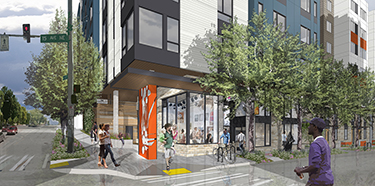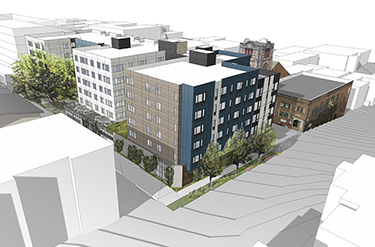|
Subscribe / Renew |
|
|
Contact Us |
|
| ► Subscribe to our Free Weekly Newsletter | |
| home | Welcome, sign in or click here to subscribe. | login |
Architecture & Engineering
| |

|
|
Design Perspectives By Clair Enlow |
November 30, 2016
Design Perspectives: Affordable housing is getting bigger and better
Special to the Journal
As part of a groundbreaking event in September, members of University Christian Church wrote wishes for their future neighbors at Arbora Court, a six-story apartment building soon to rise on the church's former parking lot across the street — on the southeast corner of 15th Avenue Northeast and Northeast 50th Street.
The wishes will become part of an art piece in the lobby.
But the church members are offering more than just good wishes. UCC let the 30,240-square-foot lot go for $4.25 million to developer Bellwether Housing. That below-market price made the project pencil out.
When it's finished in the spring of 2018, Arbora Court will house low-income people. A new parking structure will include 60 stalls owned by UCC for their members.
The 133-unit, mid-rise building designed by Weber Thompson will provide affordable housing on an urban scale. Twenty units will have three bedrooms and 30 will have two bedrooms to accommodate families with children. Forty units will be available to previously homeless people.
This is the largest project Bellwether has ever owned and operated, and probably the most energy efficient, according to Susan Boyd, Bellwether' director of real estate development. “Land (cost) is so high,” she said. “If you have the opportunity, you want to build to scale.”
Bellwether is not the only one thinking bigger. Mercy Housing is building a 108-unit project near Othello Station on land made available through Sound Transit. With support from the city, the developer went larger for the efficiencies of size. “With construction costs sky-high it's really a challenge,” said Colin Morgan-Cross of Mercy Housing.
Along with affordable housing developers, the city is also trying to secure more units at prices households earning 60 percent of median income and less can afford.
Rents and land prices are soaring in Seattle's hot real estate market, and that's leaving a lot of people out in the cold. Agencies like King County Housing Authority and Seattle Housing Authority oversee the construction and management of thousands of units, but there still is not enough for people in mid-to-low income brackets, especially in neighborhoods near transit.
It's been about a year since Seattle Mayor Ed Murray declared homelessness an emergency. The problem has only grown, and it includes families. In Seattle schools, there are thousands of children who have no place to call home.
The unit mix at Arbora Court may be a sign that the city and nonprofit housing providers that use city funds are getting serious about housing those children, too. The children who move into Arbora Court should feel safe — and also part of the growing and changing city.
Blending in
The days of towering apartment blocks or vast tracts of post-war single-family boxes, isolated from the rest of the city, are gone for good, but that doesn't mean small is better.
Mid-rise affordable housing projects will blend in with new market-rate apartment buildings along the streets of Seattle, and they can take advantage of some of the efficiencies that larger buildings enjoy.
Arbora Court is designed to complement its University District neighbors with brick and fiberboard cladding. On the inside, durable materials and low maintenance reign such as heavy doors, commercial-grade hardware, hard surface flooring and high-grade plumbing fixtures. Common areas on the first and second levels will have polished concrete floors.
Transit is a big factor. The new University of Washington light rail station site is just 1,300 feet away, according to Bellwether's Richard Loo. In addition to the land deal, Loo said the elimination of city parking requirements for designated urban villages helped make the project work. There are 53 parking stalls for 133 units, a low 0.4 ratio, in the same structure where church members will park.
Next month, Seattle Office of Housing will announce which projects get this year's city grants for affordable housing. Bellwether does not have one in this round, but the winners are likely to be on the same scale as Arbora Court and Mercy Housing's Othello project for several reasons.
Hot market
With over 100 units, each of these project will mean a real bump in the supply of affordable housing, and offer long term housing to a large number of families.
Then there's the mix of unit types. Jeff Reibman of Weber Thompson said the large size of Arbora Court allows a mix of unit sizes, and even some three-bedroom apartments for big families. Larger buildings give designers space to fit all those puzzle pieces together.
At this scale, it makes sense to add common areas like community rooms and roof decks with seating and play areas. At Arbora Court, a large roof deck will combine a play area with gathering space for residents, who will have few parks handy. Services like after-school care and financial literacy classes can be offered on site.
Efficiencies in construction help keep costs down in a superheated market where prices can derail a project. Larger buildings are inherently more energy and water-efficient, and yield savings for long-term owners like Bellwether. Durable materials and systems make them easier and cheaper to manage and maintain. Successful applicants for housing funds from the city have embraced the rigorous Evergreen Sustainable Development Standards for Affordable Housing.
And there's another reason for larger projects, according to Steve Walker of the Seattle Office of Housing. Land is scarce inside the city limits. When an opportunity like the UCC parking lot becomes available, in an area where market-rate developers tend to build as high as possible, there's an incentive to build big.
Opportunities occur in other ways too such as cheaper land and better tax credit financing terms in low-income areas, or land left unused by agencies like Sound Transit near new stations.
One major funding source for affordable housing is low-income housing tax credits. The federal program administered by the state allows investors to pay into a fund that supports housing in exchange for the right to deduct a certain amount from their taxes. But providers of equity funding like low-income housing tax credits like to spread their support among as many properties as possible, which discourages larger projects, according to Walker. So Seattle's nonprofit and for-profit housing providers have gotten good at delivering smaller projects with lots of funding sources.
Now there's more money available from the city. Voters passed another housing levy, doubling the cash available for the next round of housing. Here's another reason local funding is increasing: incentive zoning. Downtown developers have had to pay into city housing coffers, build affordable housing into their projects, or both, in exchange for the right to maximize square footage. Most have opted to pay, and the funds have been building up in the boom. Walker said 2015 was a bumper year.
Now the city's pool of long-term loan funds, which includes levy money as well as incentive zoning payments, is bringing affordable housing units on line and more are coming. Recent legislation has extended this program. All projects built inside the boundaries of urban villages where zoning allows multifamily construction will contribute.
Many people are left behind in this construction boom, but projects like Arbora Court can help them find their way home, anyway.
Clair Enlow can be reached by e-mail at clair@clairenlow.com.
Previous columns:
- Design Perspectives: ST3: Even at $54B, it's the only way to grow, 11-02-2016
- Design Perspectives: A path of great resistance in Steinbrueck Park, 10-12-2016
- Design Perspectives: Townhouses adding density to neighborhoods, 09-14-2016
- Design Perspectives: The future looks bright for Seattle's waterfront, 08-10-2016
- Design Perspectives: Occidental Park getting a great new neighbor, 07-27-2016
- Design Perspectives: Can we put a lid over our urban freeways?, 06-29-2016
- Design Perspectives -- District energy: Lots of talk, but still little action, 06-08-2016
- Design Perspectives: New paths and parks make Yesler Terrace shine, 05-04-2016




